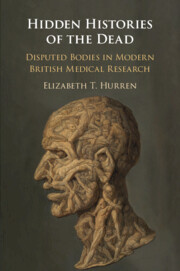Figures
1.1Re-modelling the threshold points in body bequests used for dissection and further research in the medical sciences, c. 1945–2015
4.1Remapping the threshold points of the dissected body and body parts of TAB, 5 November 1952–31 March 1954
4.2Time frame and time travels of TAB’s body: death, burial and certification
4.3The potential(s) of TAB’s threshold point(s) for the medical sciences
4.4Number of bodies supplied for dissection to St Bartholomew’s Hospital, c.1930–1965 (where N=1,072)
4.6Bodies donated and dissected in England, c. 1992–1998 (where N=3,973 [2,505 for the regions and 1,468 for London])
4.7Bodies that were donated and dissected at medical schools in England for teaching and further research purposes, c. 1992–1998
4.8Age range of body bequests dissected in England, c. 1992–1998 (where N=3,973)
4.9Number of dissected bodies analysed by gender and age range, c. 1992–1998 (where N=3,973)
5.1Coronial donated human remains (bodies and body parts, human tissue and organs) supplied to, but not officially signed off on behalf of, UMDS medical school, 1993
5.2The official procedures for donation to a medical school anatomy department under the Human Tissue Act 2004
5.3Number of post-mortems held on behalf of coroners in England and Wales, 1995–2015
7.1New paradigm of medical research threshold points in Britain, c. 1945–2015 (author designed)
7.2Body supply phases in the history of anatomy – mapped onto changing cultural concepts of the body modelled by Yuval Noah Harari, as cited in Homo Deus: A Brief History of Tomorrow, p. 388, a trend verified in three books by this author: E. T. Hurren, Dissecting the Criminal Corpse: Staging Post-Execution Punishment in Early Modern England (Basingstoke: Palgrave Macmillan, 2016) covering the 1752 to 1834 period, Dying for Victorian Medicine: English Anatomy and Its Trade in the Dead Poor, c. 1834–1929 (Basingstoke: Palgrave Macmillan, 2012) and this book detailing the 1945 to 2000 era.

